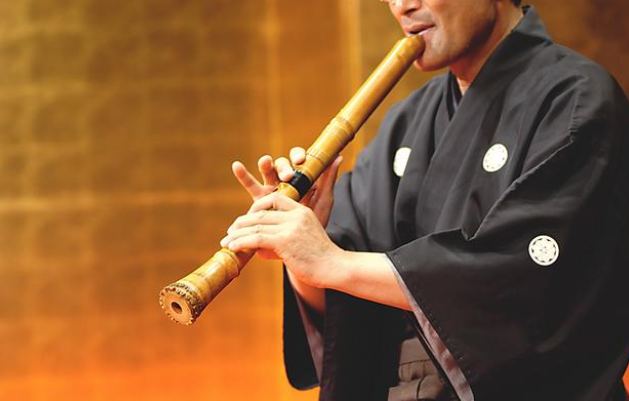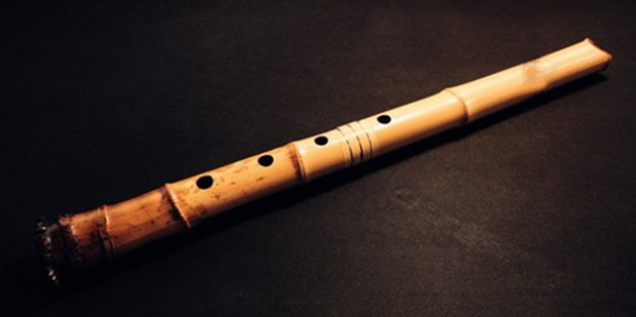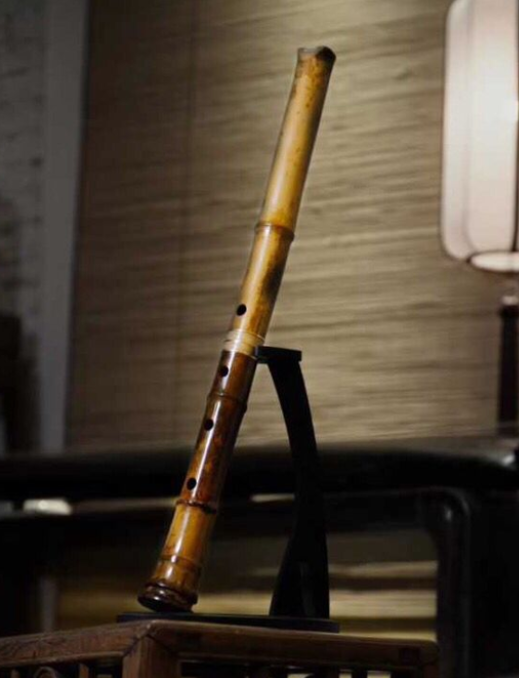Musical instruments that have disappeared in China for hundreds of years
207 views · Organized by 孤勇者 on 2022-03-03
On November 26, 1999, Zongxuan Shanchuan returned to Hangzhou to recognize his ancestors. In the misty rain, Huguo Temple played the famous shakuhachi song "Xu Duo". This is the first time Chinese people have heard this song in 750 years.
Shanchuan Zongxuan did not expect that shakuhachi has disappeared in China for hundreds of years.
That year, Song Dynasty lay Buddhist Zhang Can practiced at Renwang Temple in Huguo, Hangzhou. He would play this ancestral "Xu Duo" every morning. Whenever he played it, the Japanese monk Kuo Xin would listen to it quietly. .
The two hit it off very well, and then Zhang Can taught the shakuhachi skills to the monk Jue Xin.
In the second year of Song Baoyou, Monk Jue Xin returned to Japan with his shakuhachi making skills, and whenever he missed the East, Monk Jue Xin would play shakuhachi.
After Jue Xin passed away, Zhang Can's disciple Xuzhu wandered around Japan, built the Temple of Light and Darkness, opened the Niuwu Sect, and became the source of the six schools of Puhua.
Today, people all over the world who love the art of shakuhachi choose to study in Japan. No one knows that the hometown of shakuhachi is in China, and shakuhachi is a Chinese musical instrument.
As the last emperor of the Southern Song Dynasty threw himself into the sea to die for his country, the Mongols burned the Song Palace on the foothills of Phoenix Mountain to the flames, countless precious books were buried in the sea of fire, Huguo Renwang Temple was burned to ashes, and the monks died and fled.
Burning the qin and boiling the crane again and again, China has lost not only the skills of shakuhachi, but also the complete inheritance of Chinese traditional culture.
After learning about the desperate situation facing China's shakuhachi, Japanese shakuhachi performer Tetsuo Wada told the receptionist in Hangzhou that he wanted to stay in Hangzhou for a period of time, and he could teach shakuhachi to Chinese people who wanted to learn for free.
Professor Hetian Tetsuo's first piece is "Xu Duo", which has been extinct in China for 750 years. This piece of music created by Zhang Can's ancestors has finally returned to China.
In the main hall of Huguo Temple, Heihachiro blew the "Void Bell", "Void" and "Wuhai Chi" left by the monk Xuzhu back then, which are the Dharma songs of the Ming and Anzong sects.
After that, he came to China every year to teach shakuhachi, and he paid all the expenses for the exchange by himself.
Many Chinese people say that he is famous for his reputation, but he has no good intentions. Tsukamoto Heihachiro said: "In the past, China was the teacher of Japan and taught the Japanese many things. Now we should return the courtesy. This is a courtesy exchange."
Heihachiro Tsukamoto always prayed devoutly in the main hall of Gokokuji Temple every time he finished teaching. In China, Heihachiro learned the circulatory breathing method under the tutelage of the old flute master Zhao Songting.
Four years after his teacher passed away, Tsukamoto Heihachiro came to Taiwan. He played shakuhachi again. Many of the pieces he played this time were secret pieces. He played it one by one, showing all the skills of shakuhachi. To the fullest.
This is the promise of Tsukamoto Heihachi to his mentor Zhao Songting four years ago: to bring Shakuhachi back to China.
It is the attitude of Japan to teach shakuhachi skills to China, and it is the duty of the Chinese to learn and pass it on.
We can't keep indulging in the past and tell the world how many cultures we once had and how many musical instruments we have played. For example, musical instruments handed down from ancient times, such as shakuhachi, should not just be placed there as decorations for Chinese culture.
They are alive, to pick up, to learn, to pass on, those ancient musical instruments can maintain its vitality forever.

Shanchuan Zongxuan did not expect that shakuhachi has disappeared in China for hundreds of years.
That year, Song Dynasty lay Buddhist Zhang Can practiced at Renwang Temple in Huguo, Hangzhou. He would play this ancestral "Xu Duo" every morning. Whenever he played it, the Japanese monk Kuo Xin would listen to it quietly. .
The two hit it off very well, and then Zhang Can taught the shakuhachi skills to the monk Jue Xin.
In the second year of Song Baoyou, Monk Jue Xin returned to Japan with his shakuhachi making skills, and whenever he missed the East, Monk Jue Xin would play shakuhachi.
After Jue Xin passed away, Zhang Can's disciple Xuzhu wandered around Japan, built the Temple of Light and Darkness, opened the Niuwu Sect, and became the source of the six schools of Puhua.
Today, people all over the world who love the art of shakuhachi choose to study in Japan. No one knows that the hometown of shakuhachi is in China, and shakuhachi is a Chinese musical instrument.
As the last emperor of the Southern Song Dynasty threw himself into the sea to die for his country, the Mongols burned the Song Palace on the foothills of Phoenix Mountain to the flames, countless precious books were buried in the sea of fire, Huguo Renwang Temple was burned to ashes, and the monks died and fled.
Burning the qin and boiling the crane again and again, China has lost not only the skills of shakuhachi, but also the complete inheritance of Chinese traditional culture.
After learning about the desperate situation facing China's shakuhachi, Japanese shakuhachi performer Tetsuo Wada told the receptionist in Hangzhou that he wanted to stay in Hangzhou for a period of time, and he could teach shakuhachi to Chinese people who wanted to learn for free.
Professor Hetian Tetsuo's first piece is "Xu Duo", which has been extinct in China for 750 years. This piece of music created by Zhang Can's ancestors has finally returned to China.

In the main hall of Huguo Temple, Heihachiro blew the "Void Bell", "Void" and "Wuhai Chi" left by the monk Xuzhu back then, which are the Dharma songs of the Ming and Anzong sects.
After that, he came to China every year to teach shakuhachi, and he paid all the expenses for the exchange by himself.
Many Chinese people say that he is famous for his reputation, but he has no good intentions. Tsukamoto Heihachiro said: "In the past, China was the teacher of Japan and taught the Japanese many things. Now we should return the courtesy. This is a courtesy exchange."
Heihachiro Tsukamoto always prayed devoutly in the main hall of Gokokuji Temple every time he finished teaching. In China, Heihachiro learned the circulatory breathing method under the tutelage of the old flute master Zhao Songting.
Four years after his teacher passed away, Tsukamoto Heihachiro came to Taiwan. He played shakuhachi again. Many of the pieces he played this time were secret pieces. He played it one by one, showing all the skills of shakuhachi. To the fullest.
This is the promise of Tsukamoto Heihachi to his mentor Zhao Songting four years ago: to bring Shakuhachi back to China.

It is the attitude of Japan to teach shakuhachi skills to China, and it is the duty of the Chinese to learn and pass it on.
We can't keep indulging in the past and tell the world how many cultures we once had and how many musical instruments we have played. For example, musical instruments handed down from ancient times, such as shakuhachi, should not just be placed there as decorations for Chinese culture.
They are alive, to pick up, to learn, to pass on, those ancient musical instruments can maintain its vitality forever.
Involving musical instruments
Shakuhachi (pinyin: Chǐ bā), an ancient Chinese traditional musical instrument, was introduced to Japan during the Tang and Song Dynasties. Made of bamboo, with cinnabar mixed with lacquer on the inside to fill the (ground) incision, it is now five holes (the first four and the last one). Vast, but also can show the ethereal, quiet artistic conception.
Guess you like
Organized by 亦寒 on 2022-11-10
Recently, Peking University Business and Art Research Center collaborated with Guardian Art Center for the first time to jointly plan and launch the first Daily Art "One-day Art Marathon" activity. From 10 am to 10 PM, three annual word-of-mouth exhibitions, academic lectures and art crossover performances were integrated, which made the audience enjoy the scene. And attracted nearly 400,000 people through the network live online participation.
read >>
Organized by 拙 on 2022-06-02
The "Craftsman's Garden" in the western suburbs of Nanning, Guangxi, covering an area of 1,000 mu, was a barren farm more than ten years ago. Today, many craftsmen live here and devote their efforts to their unique craftsmanship. Lu Ming, who is accompanied by musical instruments all day long, is one of them.
read >>
Organized by Susan on 2022-05-26
If one were to choose a piece of music that would give the anxious modern soul an outlet, it would be shakuhachi. Shakuhachi, made of bamboo, is named after the length of the tube is one foot eight inches. The tone is desolate and deep, expressive, and can express the ethereal and quiet artistic conception.
read >>
Organized by ky on 2022-04-24
"When it comes to shakuhachi, many young people think of Japan or the soundtrack of "Naruto". In fact, shakuhachi is something from China." Cao Hao, 35, is a guqin teacher in Shijiazhuang and a shakuhachi maker.
read >>
Organized by 八日蝉 on 2022-04-13
The shakuhachi is a traditional bamboo wind instrument in ancient China. It was introduced to Japan during the Tang and Song Dynasties.
read >>
 渝公网安备 50010702504639号
渝公网安备 50010702504639号